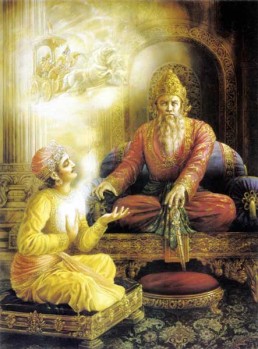Swami Chinmayananda Commentary
In those ancient days of chivalrous warfare, each honoured hero had his own personal flag, carrying on it conspicuously, a well-recognised symbol. By the flag flying on the chariot, the enemy could recognise who was the occupant of the chariot. A hero was not generally short at by an ordinary soldier, but each fought with his equal on the battle-field. This system of carrying a symbol to recognize individuals in the battle-field is faithfully followed even in modern warfare. A high official’s vehicle carries insignia of the officer’s rank on its very number-plate; on the very uniform enough details are pinned on to recognize the wearer and identify him. Arjuna’s ensign was that of a monkey.
The stanza also gives us, in hasty strokes, the information that Arjuna was impatient to start the righteous war. He had raised his instrument of war, his bow, indicating his readiness to fight.
Adi Sankara Commentary
Sri Sankaracharya did not comment on this sloka. The commentary starts from 2.10.
The Bhagavad Gita with the commentary of Sri Sankaracharya – Translated by Alladi Mahadeva Sastry
Holy Geeta – Commentary by Swami Chinmayananda
The Bhagavad Gita by Eknath Easwaran – Best selling translation of the Bhagavad Gita
The Bhagavad Gita – Translation and Commentary by Swami Sivananda
Bhagavad Gita – Translation and Commentary by Bhaktivedanta Swami Prabupadha
Srimad Bhagavad Gita Chapter 1 – Verse 21 – 1.21 senayor ubhayor – All Bhagavad Gita (Geeta) Verses in Sanskrit, English, Transliteration, Word Meaning, Translation, Audio, Shankara Bhashya, Adi Sankaracharya Commentary and Links to Videos by Swami Chinmayananda and others – 1-21

